旅游企业战略管理(双语)05
战略管理问答题含答案(双语教学版)
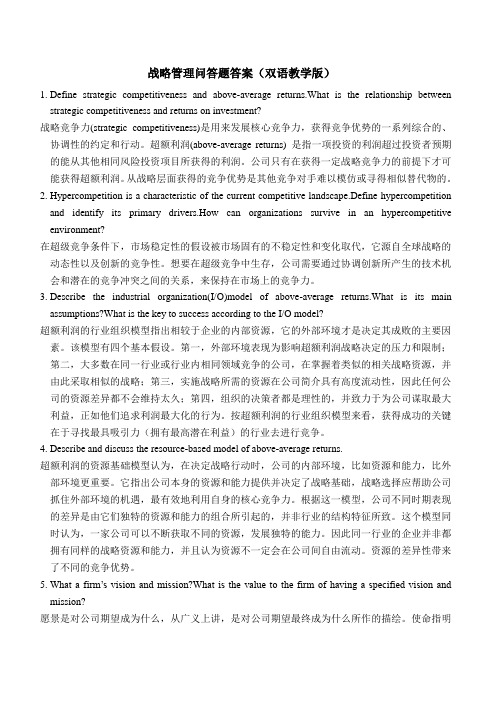
战略管理问答题答案(双语教学版)1.Define strategic competitiveness and above-average returns.What is the relationship between strategic competitiveness and returns on investment?战略竞争力(strategic competitiveness)是用来发展核心竞争力,获得竞争优势的一系列综合的、协调性的约定和行动。
超额利润(above-average returns) 是指一项投资的利润超过投资者预期的能从其他相同风险投资项目所获得的利润。
公司只有在获得一定战略竞争力的前提下才可能获得超额利润。
从战略层面获得的竞争优势是其他竞争对手难以模仿或寻得相似替代物的。
2.Hypercompetition is a characteristic of the current competitive landscape.Define hypercompetition and identify its primary drivers.How can organizations survive in an hypercompetitive environment?在超级竞争条件下,市场稳定性的假设被市场固有的不稳定性和变化取代,它源自全球战略的动态性以及创新的竞争性。
想要在超级竞争中生存,公司需要通过协调创新所产生的技术机会和潜在的竞争冲突之间的关系,来保持在市场上的竞争力。
3.Describe the industrial organization(I/O)model of above-average returns.What is its main assumptions?What is the key to success according to the I/O model?超额利润的行业组织模型指出相较于企业的内部资源,它的外部环境才是决定其成败的主要因素。
战略管理(双语课程)_南京晓庄学院中国大学mooc课后章节答案期末考试题库2023年

战略管理(双语课程)_南京晓庄学院中国大学mooc课后章节答案期末考试题库2023年1.“把鸡蛋放在一只篮子里的做法”是什么战略的形象表述参考答案:集中化战略2.进入国际市场的方式中拥有最大控制权的方式是参考答案:建立全新企业3.()是企业战略制定的出发点、依据和限制条件。
参考答案:企业能力4.确定企业宗旨必须弄清企业与()之间的关系。
参考答案:顾客5.企业现在和将来应从事什么样的事业活动,以及应成为什么性质的企业或组织类型,它反映了这个企业的()。
参考答案:企业宗旨6.一个企业为其经营活动或方式所确立的价值观、态度、信念和行为准则反映了这个企业的()。
参考答案:企业哲学7.经验效益法中的“经验”指()。
参考答案:累积产量或服务量8.企业培育核心能力最主要的方法应是()。
参考答案:利用自身力量9.环境分析技术主要有战略要素评估矩阵和( )两种参考答案:SWOT分析10.那些现有和潜在竞争对手极少能拥有的能力,是企业核心能力判断标准的()标准。
参考答案:独特的能力11.企业是否有科学的文化建设目标、计划、工作内容、预算保证等属于企业文化分析中的()。
参考答案:文化建设分析12.在企业财务能力分析中,考察企业在一定时期内经营能力的发展变化趋势采用()。
参考答案:成长性指标13.如果企业处于SWOT矩阵的第Ⅱ象限,那么宜采取的战略是( )。
参考答案:先稳定后发展战略14.企业的竞争优势源于()。
参考答案:企业的核心竞争力15.分析资源利用情况,原则上运用()来进行。
参考答案:产出与资源投入的比率16.企业更愿意将()作为企业能力和核心竞争力的基础。
参考答案:无形资源17.被称为特殊有形资源的是()。
参考答案:人力资源18.战略管理的目的是()。
参考答案:提高企业的环境适应能力19.董事会参与程度低、高层管理者参与程度高的企业战略管理方式属于()。
参考答案:自由企业家式管理20.董事会参与程度高、高层管理者参与程度高的企业战略管理方式属于()。
《旅游学概论(双语)》-课程教学大纲

《旅游学概论(双语)》课程教学大纲一、课程基本信息课程代码:20080132课程名称:旅游学概论(双语)英文名称:Introduction to Tourism Studies课程类别:基础课学时:30学分:2适用对象:旅游管理专业本科生考核方式:考试先修课程:管理学市场营销学财务管理等二、课程简介本课程是旅游管理专业的基础课,主要研究旅游系统的各个要素及其相互关系的一门学科。
其主要内容包括旅游发展史、旅游系统、旅游目的地、旅游业、旅游需求、旅游营销、旅游对社会、经济、文化、环境等方面的影响,以及世界旅游业发展趋势等。
通过该课程的学习,学生可以掌握旅游业的基本知识和基本理论,具有初步分析问题和解决问题的实际能力。
Introduction to Tourism Studies is a basic course of tourism management major, which mainly studies tourism system and their relationship of the elements of tourism system. This course mainly include the history of tourism development, tourism system, tourist destination, tourism sector, tourism demand, tourism marketing, the economic consequences of tourism, the environment consequences of tourism, the social and cultural consequences of tourism, and tourism futures. This course can help students have a good understanding of the basic theory and knowledge of tourism, as well as have fundamental ability in analyzing and solving academic and practical problems.三、课程性质与教学目的课程性质:旅游管理专业的基础课教学目的:1.使学生了解旅游活动的产生与发展,掌握旅游发展史的阶段划分及主要特点、主要事件;2.认识旅游系统模型和主要组成要素;3.认识旅游目的地的主要特征,主要要素,以及掌握旅游目的地生命周期理论。
旅游企业战略管理---多元化战略成功的必要条件 ---以华侨城集团为例
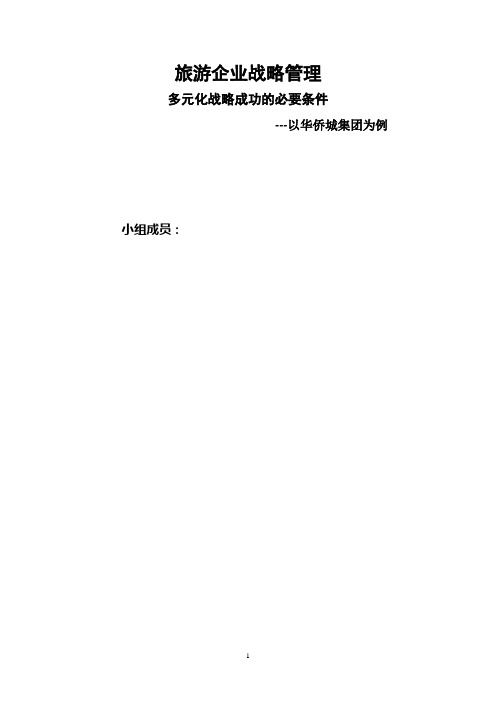
旅游企业战略管理多元化战略成功的必要条件---以华侨城集团为例小组成员:多元化战略成功的必要条件---以华侨城集团为例1.华侨城简况华侨城集团成立于1985年11月11日,是隶属于国务院国资委管理的大型中央企业之一。
成立二十多年以来,由深圳湾畔的一片滩涂起步,发展成为一个跨区域、跨行业经营的大型国有企业集团,培育了房地产及酒店开发经营、旅游及相关文化产业经营、电子及配套包装产品制造等三项国内领先的主营业务。
华侨城集团公司长期致力于发展有中国特色的文化产业集群,将塑造成为中国最具创想文化和影响力的企业,并通过独特的创想文化致力于提升中国人的生活品质。
旗下拥有华侨城控股(SZ000069)、华侨城(亚洲)控股(3366. HK)、康佳集团(SZ000016)三家境内外上市公司以及锦绣中华、民俗文化村、世界之窗、欢乐谷、波托菲诺、新浦江城、何香凝美术馆、OCT-LOFT创意文化园、华夏艺术中心、长江三峡旅游、华侨城大酒店、威尼斯酒店、茵特拉根大酒店、城市客栈等一系列国内著名的企业和产品品牌。
是少数几个连续六年入选中国企业500强的企业之一。
与此同时,随着深圳东部华侨城,深圳西部华侨城,北京华侨城,成都华侨城,上海华侨城,云南华侨城,西安华侨城,天津华侨城,武汉华侨城,及泰州华侨城多个大型综合性旅游项目和高尚居住社区的先后投资建设,华侨城集团全国发展的战略布局已经形成。
华侨城集团将以更加创新和开放的姿态,并以强大的生机活力和崭新的形象走向未来,谱写更加辉煌的乐章。
1.1 华侨城地产华侨城是最早被列为国务院国资委大力扶持发展房地产业的全国五大中央企业之一。
率先倡导“花园中建城市”、“规划就是财富”、“环境就是优势”等现代发展理念,形成了“以旅游主题地产为特色的成片综合开发和运营”模式,为深圳乃至全国的城市规划建设提供了有益的经验和经典的示范作用,成为蜚声海内外的花园城区建设的综合运营机构——不仅涵盖了传统意义上房地产开发的所有形态,包括住宅、别墅、公寓、商业、写字楼、酒店、创意产业园,如东方花园、海景花园、湖滨花园、中旅广场、锦绣花园、波托菲诺、曦城、新浦江城、华侨城沃尔玛购物广场、波托菲诺商业街、汉唐大厦、威尼斯酒店、海景酒店、城市客栈、华侨城国际青年旅舍、OCT-LOFT 华侨城创意文化园等;而且涵盖更宽泛范畴,包括何香凝美术馆、OCT当代艺术中心、华夏艺术中心以及学校、医院、体育中心、高尔夫球俱乐部等,是建筑类别最齐全、产品线最丰富的房地产企业之一,并发展成为“中国旅游主题地产第一品牌”。
旅游企业战略管理课后思考题参考答案(第1章)
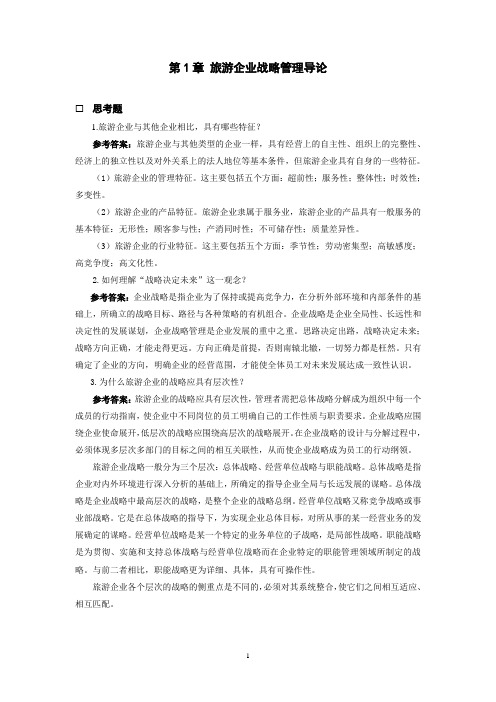
第1章旅游企业战略管理导论思考题1.旅游企业与其他企业相比,具有哪些特征?参考答案:旅游企业与其他类型的企业一样,具有经营上的自主性、组织上的完整性、经济上的独立性以及对外关系上的法人地位等基本条件,但旅游企业具有自身的一些特征。
(1)旅游企业的管理特征。
这主要包括五个方面:超前性;服务性;整体性;时效性;多变性。
(2)旅游企业的产品特征。
旅游企业隶属于服务业,旅游企业的产品具有一般服务的基本特征:无形性;顾客参与性;产消同时性;不可储存性;质量差异性。
(3)旅游企业的行业特征。
这主要包括五个方面:季节性;劳动密集型;高敏感度;高竞争度;高文化性。
2.如何理解“战略决定未来”这一观念?参考答案:企业战略是指企业为了保持或提高竞争力,在分析外部环境和内部条件的基础上,所确立的战略目标、路径与各种策略的有机组合。
企业战略是企业全局性、长远性和决定性的发展谋划,企业战略管理是企业发展的重中之重。
思路决定出路,战略决定未来;战略方向正确,才能走得更远。
方向正确是前提,否则南辕北辙,一切努力都是枉然。
只有确定了企业的方向,明确企业的经营范围,才能使全体员工对未来发展达成一致性认识。
3.为什么旅游企业的战略应具有层次性?参考答案:旅游企业的战略应具有层次性,管理者需把总体战略分解成为组织中每一个成员的行动指南,使企业中不同岗位的员工明确自己的工作性质与职责要求。
企业战略应围绕企业使命展开,低层次的战略应围绕高层次的战略展开。
在企业战略的设计与分解过程中,必须体现多层次多部门的目标之间的相互关联性,从而使企业战略成为员工的行动纲领。
旅游企业战略一般分为三个层次:总体战略、经营单位战略与职能战略。
总体战略是指企业对内外环境进行深入分析的基础上,所确定的指导企业全局与长远发展的谋略。
总体战略是企业战略中最高层次的战略,是整个企业的战略总纲。
经营单位战略又称竞争战略或事业部战略。
它是在总体战略的指导下,为实现企业总体目标,对所从事的某一经营业务的发展确定的谋略。
企业战略管理双语教学的探索与实践
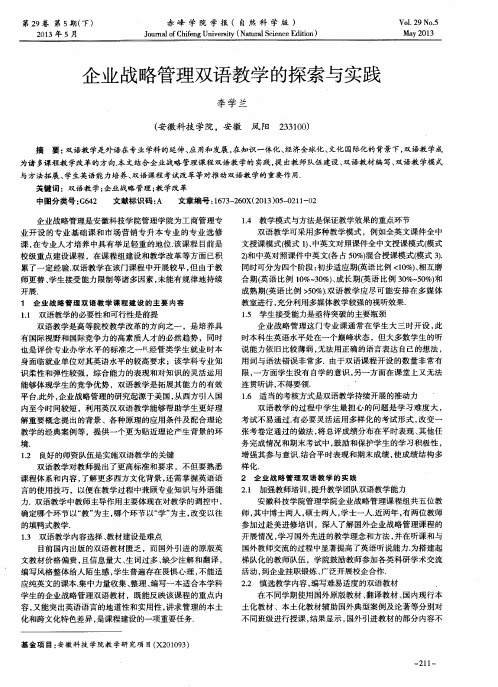
为诸 多课 程教 学改革的方向. 本文结合企业战略 管理课程 双语教 学的 实践 , 提 出教 师队伍 建设 、 双语教材 编写、 双语教 学模式
与方法拓展 、 学生英语能力培养、 双语课程考试 改革等对推动双语教 学的重要作用.
关键 词 :双语教 学 ; 企业战略管理 ; 教 学改革 中图分 类号 : G 6 4 2 文献标识码 : A 文章编号 : 1 6 7 3 — 2 6 0 X( 2 0 1 3 ) 0 5 — 0 2 1 1 — 0 2
累了一定经验 . 双语教学 在该 门课程 中开展较早 , 但 由于教
文授课模式( 模式 1 ) 、 中英文对照课件全中文授课模式( 模式
2 ) 和中英对照课件 中英文 ( 各 占5 0 %) 混合授课模式( 模式 3 ) .
师更替 、 学生接受能 力限制等诸多 因素 , 未能有规律地 持续
企业 战略管理是安徽科技学 院管理 学院为工商管 理专
1 . 4 教学模式与方法是保证教学效果 的重点环节 双语教学可采用多种教学模式 ,例 如全英文课件全 中
业 开设 的专 业基 础课 和市场 营销 专升 本专 业 的专业 选 修 课, 在专业 人才培养 中具 有举足轻重 的地位. 该课 程 目前是 校级 重点建设 课程 ,在课程组建设 和教 学改革等方 面 已积
教室进行 , 充分利用多媒体教学较强的视 听效果. 1 . 5 学生接受能力是亟待突破 的主要瓶颈
企业 战略管理这 门专业课 通常在 学生大 三时开设 , 此
1 . 1 双语教 学的必要性 和可行性是前提 双语 教学是高等院校教学改革 的方 向之一 ,是 培养具
有 国际视 野和国际竞争力 的高素质人 才的必然趋势 ,同时
旅游企业战略管理

旅游企业战略管理全文共四篇示例,供读者参考第一篇示例:一、旅游企业战略管理的定义旅游企业战略管理是指企业在动态的市场环境中,对企业的使命、愿景、目标和资源进行有效规划和整合,以实现长期发展和可持续竞争优势的过程。
它包括了企业整体规划、资源配置、目标设定、执行控制等方面的内容,旨在帮助企业应对外部环境的变化,实现组织与环境的良性互动。
旅游企业战略管理的重要性不言而喻。
战略管理有助于企业明确发展方向和目标,提高企业的适应性和灵活性,为企业未来的发展奠定基础。
通过制定有效的战略计划,企业能够有效地利用资源,提高企业的经营效率和利润。
战略管理可以帮助企业预测和应对市场的变化,降低企业的风险和不确定性。
通过战略管理,企业能够实现组织内外部协调一致,提高企业的核心竞争力,赢得市场竞争的优势。
旅游企业战略管理的目标是实现企业的长期发展和可持续竞争优势。
具体来说,它包括以下几个方面:1. 确定企业的使命和愿景。
企业应根据自身的定位和优势,明确自己的使命和愿景,为企业的发展提供明确的方向和动力。
2. 制定企业的长远发展战略。
企业应根据市场环境和内部资源情况,制定符合企业发展阶段和目标的战略规划,包括市场定位、产品战略、营销策略等方面。
3. 优化资源配置。
企业应合理配置资源,确保资源的有效利用和最大化价值,提高企业的经营效益和盈利能力。
4. 提高组织的灵活性和适应性。
企业应不断调整和优化战略,以适应市场的变化和挑战,保持组织的创新和竞争力。
5. 实施战略监控和评估。
企业应设立有效的战略监控机制,及时进行战略评估和调整,确保战略的有效实施和达成目标。
旅游企业战略管理的实施步骤一般包括以下几个方面:1. 环境分析。
企业应对外部环境和内部资源进行全面分析,包括市场需求、竞争对手、政策法规等方面,为企业战略规划提供基础数据和依据。
3. 实施战略。
企业应将战略规划付诸实施,包括资源配置、组织调整、市场推广等方面,确保战略的有效实施和落地。
旅游企业战略概述

(二)旅游企业的经济性质
➢ 1.社会分工与旅游企业
分工提高了生产效率,人们有更多的收入和闲暇, 旅游者的出行在客观上成为可能;
分工强化了人们出游的动机,旅游成为主管需要。
➢ 2.旅游企业的范围
旅游企业的规模 旅游企业的业务范围
➢ 3.旅游企业的所有权、激励与控制
二、旅游企业产品和服务的特征
产品—市场的范围; 地理范围; 各职能战略的支持与配合; 事业的宗旨和战略目标。
3.职能战略
➢职能战略是在贯彻、实施和支持企业总 体战略与事业部战略时为企业特定的职 能管理领域制定的战略。通常包括:
生产战略; 营销战略; 财务战略; 人力资源战略等。
(二)旅游企业战略的种类
➢ 1.以战略目标为标准 ➢ 成长战略(发展战略)
逃避现实的体验 审美的体验 教育的体验 娱乐的体验
三、旅游企业的行业特性
➢(一)中小企业占多数的行业 ➢(二)复杂性和多样性 ➢(三)相互依赖性 ➢(四)冲突和不和谐性
第二节 旅游企业战略概述
➢一、旅游企业战略的概念 ➢战略:strategy
战略一词最初应用于军 事领域,古称韬略,是
指作战的谋略。
➢(一)旅游服务具有服务的一般属性 ➢1.无形性 ➢2.生产与消费的同步性 ➢3.易逝性 ➢4.异质性
(二)旅游服务区别于其他服务 业的特性
➢1.季节性 ➢2.脆弱性 ➢3.易模仿性 ➢4.经营证据和形象的重要性 ➢5.分销渠道的多样性和重要性 ➢6.相互依赖性
(三)体验经济时代的旅游服务
➢旅游服务作为一种体验品,主要向旅游 者提供以下四种体验:
➢(一)旅游企业战略管理过程 ➢1.战略分析 ➢2.战略选择 ➢3.战略实施
1.战略分析
旅游企业战略管理实训教材

旅游企业战略管理实训教学大纲(Strategic Management of Tourism Enterprises)(供四年制旅游管理专业2012级试用)课程编号:面向专业:旅游管理实验类别:专业课实验实验时数:6考核方式:考试实验总的目的与要求:通过教学,使学生掌握旅游企业的构成原理、生产经营决策、生产经营优化决策、生产经营决策全面预算的基本原理,熟悉旅游企业战略分析、制定、实施等方法和工具,从而具备良好的旅游企业战略管理实际应用能力。
其中:验证性实验 0 %,设计性实验 0 %,综合性实验 100 %教材及参考书目:[1]严伟,蔡蓉蓉编.旅游企业战略管理.第二版.上海:上海交通大学出版社 ,2011[2]邹益民编.旅游企业战略管理.第二版.北京:中国人民大学出版社,2009[3]蓝海林,张平编. 战略管理:中国情景下的企业战略行为.第一版.北京:机械工业出版社,2012[4]田泽,马海良编. 国际企业管理——文化、战略与行为.第一版.北京:清华大学出版社,2012[5]张东生主编. 企业战略管理.第二版.北京:机械工业出版社,2011[6] 黄其新,陈伟军主编. 服务性企业战略管理.第一版.北京:北京大学出版社,2011执笔人:章怡审核人:龚艳教学院长:刘曙霞旅游企业战略管理课程实训指导书章怡编写目录实验一旅游企业外部环境分析实验二旅游企业内部环境分析实验三旅游公司战略实验一旅游企业外部环境分析实验时数:2课时实验目的和要求:1.了解并掌握旅游企业各部门的工作构成及原理;2.了解旅游企业生产经营活动中各种决策。
实验内容:通过对酒店外部环境的调查和分析,使学生完成以下内容:1.了解不同旅游企业的工作构成及其原理;2.掌握目前所调研的旅游企业在经营决策中外部环境分析的主要方法;3.熟悉目前旅游企业在经营决策外部环境分析时存在的问题。
旅游企业外部环境分析内容及方法:旅游企业宏观环境分析一、社会环境:人口方面的变化(人口的流动、老年人市场和女性旅游者)、各国城市化进程的不断加快、疾病与健康问题。
旅游企业战略管理课后思考题参考答案(第2章)

第2章旅游企业环境条件分析思考题1.分析旅游企业的宏观环境对旅游企业战略管理有何意义?参考答案:(1)在旅游企业的组织外部,客观存在着诸多与企业经营管理活动有关的宏观环境因素,包括政治环境、经济环境、社会环境和技术环境等诸多方面。
(2)宏观环境虽然不在企业管理者的短期控制范围内,但确实影响企业未来经营活动的运行和经营成果的获得。
(3)分析旅游企业所处的宏观环境有助于企业识别外部机会与威胁因素,正确把握战略发展方向,为构建持续的竞争优势奠定基础。
2.如何认识旅游行业集中度与旅游企业战略的关系?参考答案:(1)行业集中度是指行业少数几个最大企业的有关数值(如产值、产量、销售额、销售量、员工人数、资产总额等)占整个市场或行业的份额。
(2)旅游行业集中度是衡量该行业的产量或市场份额向行业核心企业集中程度的一个指标,也是衡量该行业(市场)竞争程度的主要标志。
集中度越低说明旅游企业所在行业的竞争越激烈,但同时也可能意味着全行业盈利能力低下,缺乏竞争优势企业。
(3)准确认识旅游行业的集中度有助于旅游企业结合自身实力找准战略定位,更好地构建与提升竞争优势。
3.中国企业目前的时代背景对旅游企业管理主要有哪些影响?参考答案:(1)大局稳定的政治环境。
这为国内旅游企业的发展奠定了良好的基础,也成为吸引外资的最关键因素。
(2)错综复杂的文化环境。
中国传统文化的精华和糟粕并存,需要旅游企业在管理中进行扬弃;新的文化类型不断涌现,包括商业文化、网络文化、明星文化等,为旅游企业注入了新的思想和活力,有助于旅游企业管理的不断创新;外来文化的冲击在当前也表现得尤为显著,旅游企业必须重视这一现象,并充分利用其中存在的机会与避免潜在的威胁。
(3)更新换代的经济环境。
从计划经济向市场经济的全面转变,使旅游企业的市场空间不断扩大,服务对象日趋成熟,竞争层次不断升级,市场秩序日趋规范;从工业经济向知识经济的转变,决定了旅游企业需要不断加大对人才与科技的投入;从区域经济向全球经济的迈进,将进一步扩大中国旅游企业的经营空间,同时将提高旅游企业管理的国际化程度。
《旅游企业战略管理》第1章:旅游企业战略概述

第1章 旅游企业战略概述
【学习目标】
知识点 1.了解旅游企业、旅游产品、旅游行业的概念、特征。
2.掌握旅游企业战略的概念、特征、类型和制定过程。 3.掌握SWOT分析法。
技能点 1.能够利用SWOT分析法对旅游企业面临的战略环境进行分析。
2.制定相应战略对策。
【导入案例】金陵饭店集团公司的战略管理
1.1.1 旅游企业的类型和发展趋势
1)企业的基本特征
(1)企业具有明确的产权归属关系。 (2)企业是法律和经济上独立自主的实体,是具有一定权利和义务的法人。 (3)企业与其他交易者之间地位平等,权利平等。 (4)企业以盈利为目的。 (5)企业的生成和经营活动的风险性。
2020/4/18
3
第1章 旅游企业战略概述
旅游企业战略就是能从根本上阐明旅游企业的经营现状、未来目标与存在 意义,综合体现旅游企业外部环境、使命目标及内部实例的整体发展思想 的理论框架。
2020/4/18
6
1.2.2 旅游企业战略的类型
1)总体战略 2)竞争战略或经营战略 3)职能战略
第1章 旅游企业战略 旅游企业战略概述
2020/4/18
1
第1章 旅游企业战略概述
本章纲目
➢ 1.1 旅游企业概述 ➢ 1.2 旅游企业战略概述
2020/4/18
2
第1章 旅游企业战略概述
1.1 旅游企业概述
旅游企业定义:
旅游企业是能够以旅游资源为依托,以有形的空间设备、资源和无形的服 务效用为手段,在旅游消费服务领域中进行独立经营核算的经济单位。
2020/4/18
11
(1)旅游企业集团化势在必行。 (2)旅游产品趋向多样化与个性化。 (3)旅游企业的经营将趋向国际化与全球化。 (4)旅游企业营销将趋向网络化。 (5)旅游企业的服务将趋向优质化。 (6)旅游企业的可持续化发展。
2021级旅游企业战略管理期末考(1)
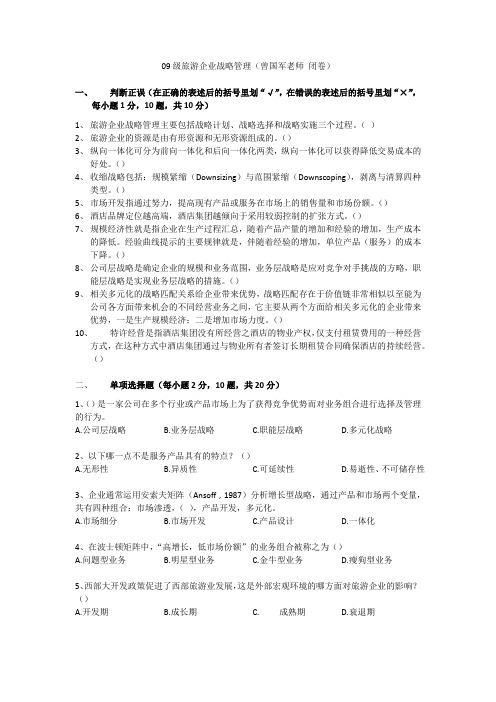
09级旅游企业战略管理(曾国军老师闭卷)一、判断正误(在正确的表述后的括号里划“√”,在错误的表述后的括号里划“×”,每小题1分,10题,共10分)1、旅游企业战略管理主要包括战略计划、战略选择和战略实施三个过程。
()2、旅游企业的资源是由有形资源和无形资源组成的。
()3、纵向一体化可分为前向一体化和后向一体化两类,纵向一体化可以获得降低交易成本的好处。
()4、收缩战略包括:规模紧缩(Downsizing)与范围紧缩(Downscoping),剥离与清算四种类型。
()5、市场开发指通过努力,提高现有产品或服务在市场上的销售量和市场份额。
()6、酒店品牌定位越高端,酒店集团越倾向于采用较弱控制的扩张方式。
()7、规模经济性就是指企业在生产过程汇总,随着产品产量的增加和经验的增加,生产成本的降低。
经验曲线提示的主要规律就是,伴随着经验的增加,单位产品(服务)的成本下降。
()8、公司层战略是确定企业的规模和业务范围,业务层战略是应对竞争对手挑战的方略,职能层战略是实现业务层战略的措施。
()9、相关多元化的战略匹配关系给企业带来优势,战略匹配存在于价值链非常相似以至能为公司各方面带来机会的不同经营业务之间,它主要从两个方面给相关多元化的企业带来优势,一是生产规模经济;二是增加市场力度。
()10、特许经营是指酒店集团没有所经营之酒店的物业产权,仅支付租赁费用的一种经营方式,在这种方式中酒店集团通过与物业所有者签订长期租赁合同确保酒店的持续经营。
()二、单项选择题(每小题2分,10题,共20分)1、()是一家公司在多个行业或产品市场上为了获得竞争优势而对业务组合进行选择及管理的行为。
A.公司层战略B.业务层战略C.职能层战略D.多元化战略2、以下哪一点不是服务产品具有的特点?()A.无形性B.异质性C.可延续性D.易逝性、不可储存性3、企业通常运用安索夫矩阵(Ansoff , 1987)分析增长型战略,通过产品和市场两个变量,共有四种组合:市场渗透,(),产品开发,多元化。
旅游企业管理名词解释

旅游企业管理名词解释一、目的地管理目的地管理是旅游企业管理中的一个重要概念,指的是对旅游目的地进行全面的规划、开发和管理的过程。
目的地管理旨在提升旅游目的地的吸引力和竞争力,以满足游客的需求,并促进旅游业的可持续发展。
目的地管理涉及到对旅游资源的开发和保护、旅游产品的设计和推广、旅游基础设施的建设和维护等方面。
目的地管理需要综合考虑旅游目的地的自然环境、文化背景、社会经济状况等因素,并与相关利益相关者进行合作,共同推动目的地的发展。
目的地管理包括对旅游产品和服务的定位和市场定位,通过市场调研和营销策略来吸引目标游客群体,提供丰富多样的旅游体验。
二、旅游业态旅游业态是指旅游产品和服务的不同形式和类型。
旅游业态涵盖了旅游的多个领域,包括酒店住宿、旅行社、景区景点、餐饮娱乐等。
不同的旅游业态有不同的特点和需求,旅游企业需要根据自身的经营定位和目标市场选择适合的业态。
旅游业态的发展与旅游目的地的特点密切相关。
一些地区由于其自然环境或文化特色而适合发展特定的旅游业态,例如海滨城市适合发展度假酒店和海洋主题公园,历史文化名城适合发展文化旅游和遗产旅游。
旅游企业需要根据目的地的特点和市场需求,结合自身的竞争优势和资源条件,选择合适的旅游业态来进行经营和发展。
三、旅游资源管理旅游资源管理是指对旅游资源进行有效开发、保护和管理的过程。
旅游资源是旅游业的基础,包括自然景观、文化遗产、人文景观等,是吸引游客和提供旅游体验的重要依托。
旅游资源管理需要综合考虑资源的可持续利用和保护,以及游客的需求和市场竞争的要求。
管理旅游资源涉及到资源的评估和分类,开发和利用计划的制定,资源的保护和恢复措施的采取等。
良好的旅游资源管理能够有效平衡旅游业的发展和生态环境的保护,在保证资源可持续利用的同时,提供丰富多样的旅游产品和服务。
同时,旅游企业也需要积极参与旅游资源管理,加强与相关机构和社会团体的合作,共同推动旅游资源的可持续发展。
四、旅游市场营销旅游市场营销是指在旅游市场上推广和销售旅游产品和服务的过程。
旅游企业战略管理试题库答案试题库(第5章)

第5章旅游企业连锁经营发展战略一、单项选择题1.一般来说,连锁企业在其业务发展的早期阶段,大多采用()的连锁经营形式。
A.委托管理B.特许经营C.直接经营D.其他形式答案:C2.直接经营最突出的特点是()。
A.雄厚的资本B.规范的经营制度C.良好的企业形象D.所有权和经营权高度集中答案:D3.()是指经营同类商品、服务的若干企业,在连锁经营企业总部的组织领导下,采取共同经营方针和统一行动,实行集中采购和分散销售有机结合,通过规范化经营服务,实现规模经济效益的经营模式。
A.合资经营B.特许经营C.直接经营D.连锁经营答案:D4.将一定区域内的独占特许权授予受许方,受许方在该地区内可以独自经营,也可以再次授权给下一个受许方经营业务。
这种特许经营方式属于()。
A.一般特许经营B.复合特许经营C.委托特许经营D.授权特许经营答案:B5.旅游企业采用(),可以使企业节省巨额的固定资产投资,因为企业只需要向业主交付一定的租金,即可获得该企业的经营权。
A.自建企业B.合资企业C.收购兼并D.租赁经营答案:D6.特许加盟者加入特许企业,首先考虑的是()。
A.特许企业的实力B.特许企业的品牌C.特许企业的产品D.特许企业的服务质量答案:B7.具有同一资本、集中管理、分散经营,在是()的特点。
A.直接经营B.委托管理C.连锁经营D.特许经营答案:A8.两个或两个以上不同国家或地区的投资者共同投资建成的具有法人地位的企业称为()。
A自建企业 B.特许经营 C.合资企业 D.收购答案:C9.在下列选项中,()不属于旅游企业连锁经营的形式。
A.直接经营B.特许经营C.委托管理D.多元化经营答案:D10.经营权的商品化是()的特征。
A.特许经营B.直接经营C.委托管理D.租赁经营答案:C二、多项选择题1.旅游企业连锁经营的主要特征有()。
A.经营方式一体化B.管理模式标准化C.企业形象统一化D.所有权与经营权高度集中E.经营权的私有化与商品化答案:ABC2.与传统的经营模式相比较,连锁经营的优势有()。
《旅游企业战略管理》论文(案例)题目

东财网院2009年3月课程考试《旅游企业战略管理》案例(共三个案例,任选一个案例写作)案例分析1:雅高是一个总部设在巴黎的多品牌的酒店网络,它在90个国家拥有3600个不同的酒店。
几年来这一网络已经归属于著名的品牌雅高酒店集团的旗帜之下。
酒店的发展以著名的国际品牌为基础(例如Sofitel,Novotel,Mercure,Ibis,还有美国的Formule 1,otel 6和Red Roof),包括了从经济型到豪华型所有档次的酒店。
雅高的产业已经遍布全球,特别是在美洲、欧洲、和亚洲都有它的足迹。
在2001年的春季,旅行业就已显示了明显的滑坡,接着而来的9.11恐怖袭击事件又使已不景气的旅游业遭受了历史上最为惨重的打击之一。
这一恐怖事件产生了两种结果。
一个是立即的、前所未有的巨大的心理震撼。
第二个是同时波及美洲、欧洲、亚洲的全球经济衰退。
雅高集团通过集团在不同地区酒店档次的多样化,保护了自己并使自己少受这一外部环境的负面影响。
当然,对酒店预订的整体影响是不可避免的;例如,巴黎的豪华酒店业遭受到了严重的影响,但是欧洲的经济型酒店的预定有所增长。
Sofitel的预订业务在2001年的10月下降了33%,同年11月份下降了18%;同时Formule 1和Ibis等欧洲的经济型酒店,它们的预定在10月份上升了3.5%,在11月份上升4.6%。
在美国,Sofitel的预订下降了25—30%,然而在同一时期红屋顶(Red Roof)酒店和第六汽车旅馆(Motel 6),它们的预定却只下降了9.2%和6%。
请根据上述材料分析:(1)旅游服务的特点有哪一些?(2)上述案例指的是哪一种特点?(3)旅游企业的管理人员应该如何规避这种风险。
字数2000~3000字。
案例分析2:在航空业,所有的航空公司都拥有经营航班所要求的能力和资源。
英国航空公司拥有的核心竞争力与下列内容有关:占有伦敦希思罗机场起降滑道的优势;拥有经营特定线路的特许权,这一权利阻止了其他航空公司的进入;品牌特性是它获得能提供高质量服务声誉的基础。
企业战略管理双语B卷

《企业战略管理(双语)》B卷一、选择题(每题2分,共50分)1. What separates a powerful strategy from an ordinary or weak one isA) the ability of the strategy to keep the company profitable.B) management's ability to forge a series of moves, both in the marketplaceand internally, that produce sustainable competitive advantage.C) the speed with which it helps the company achieve its strategic vision.D) the proven ability of the strategy to generate maximum profits.E) whether it allows the company to take sales and market share away fromrivals.Answer: B Difficulty: Medium2. A winning strategy is one thatA) builds strategic fit, is socially responsible, and maximizes shareholderwealth.B) is highly profitable and boosts the company's market share.C) results in a company becoming the dominant industry leader.D) fits the company's internal and external situation, builds competitiveadvantage, and boosts company performance.E) can pass the ethical standards test, the strategic intent test, and theprofitability test.Answer: D Difficulty: Medium3. The rivalry among competing sellers tends to be less intense whenA) buyer switching costs are low.B) the costs of exiting the market are higher than the costs of new entry.C) industry rivals are not particularly aggressive or active in employing thevarious weapons of competition (a lower price, frequent introductions ofnew features or new models, new advertising campaigns, new customerservice features, and so on) to try to draw sales and market share awayfrom rivals.D) rivals have diverse strategies and objectives and are located in differentcountries.E) competitive rivalry is centered on non-price factors rather aggressiveefforts to sell at the lowest possible price.Answer: C Difficulty: Medium4. Managerial jobs with strategy-making responsibilityA) are found only at the vice-president level and above in most companies.B) are more common in profit-seeking organizations than in not-for-profitorganizations.C) are relatively rare because most strategy-making is done by the membersof a company's board of directors.D) seldom exist within a functional department (e.g., marketing and sales) orin an operating unit (a plant or a district office) because these levels of theorganization structure are well below the level where strategic decisionsare typically made.E) extend throughout the managerial ranks and exist in every part of acompany business units, operating divisions, functional departments,manufacturing plants, and sales districts.Answer: E Difficulty: Medium5. A company's strategic visionA) concerns "what approach should we take to implement and execute ourbusiness model?"B) provides an answer to "who are we, what do we do, and why are wehere?"C) is typically focused on a company's present business scope (its presentcapabilities, customer focus, activities, and business makeup) and whatneeds to be done to successfully outcompete rivals in the marketplace.D) addresses the issue of "where we are going and why."E) deals with "what should we do to make our strategy work as planned?"Answer: D Difficulty: Medium6. Functional strategiesA) add relevant detail to the overall business strategy by setting forth theactions, approaches, and practices to be employed in managingparticular functions or business process or key activities within a business.B) address the specific strategic issues and problems a business confronts.C) are normally crafted by the executive in charge of the overall business.D) are concerned with how to unify the firm's skills, competencies, andresource strengths.E) are normally crafted by the company's CEO and other senior executives.Answer: A Difficulty: Medium7. Successful differentiation allows a firm toA) be the industry's best-cost provider.B) be the industry's best quality provider.C) be the industry's most respected provider.D) command a premium price for its product and/or increase unit sales(because additional buyers are won over by the differentiating features),and/or gain buyer loyalty to its brand (because some buyers are stronglyattracted to the differentiating features).E) compete on the basis of a lower price than rivals.Answer: D Difficulty: Medium8. The strategy of a firm using a global strategy is likely to entailA) a narrow selection of models and styles, with each model/style focused onidentified international market niches.B) producing and marketing mostly standardized products worldwide, withsome customization where and when necessary.C) producing the company's products at numerous plants scattered around theworld.D) selling the company's products under a wide variety of brand names sothat buyers in each country market would think they are buying alocally-made brand.E) selling direct to buyers (usually via the company's website) to avoidhaving to establish networks of wholesale/retail dealers in each countrymarket.Answer: B Difficulty: Easy9. The difference between the concept of a company mission statement and theconcept of a strategic vision is thatA) a mission statement typically concerns a company's present business scopeand purpose whereas the principal concern of a strategic vision is with thecompany's long term direction and future business make-up.B) the mission is to make a profit, whereas the strategic vision is whatbusinesses to be in to try to make a profit.C) a mission statement deals with what to accomplish on behalf ofshareholders and a strategic vision concerns what to accomplish on behalfof customers.D) a mission concerns what to do to achieve short-run objectives and astrategic vision concerns what to do to achieve long-run performancetargets.E) a mission statement deals with "where we are headed " whereas a strategicvision provides the critical answer to "how will we get there?"Answer: A Difficulty: Medium10. A company strength can relate toA) its human, physical and/or organization assets, its competitive capabilities,an achievement or attribute that puts the company in a position of marketadvantage, or competitively valuable partnerships or alliances.B) having quick ability to move from one strategic group to another.C) the capabilities it has for shifting back and forth between one value chainand another, how often it does strategic cost analysis, and whether it doesbenchmarking better than its rivals.D) whether it has more collaborative partnerships and strategic alliances withother organizations than do its close rivals.E) having more shareholders than rival firms.Answer: A Difficulty: Medium11. A company's "macro-environment" refers toA) the immediate industry and competitive conditions with which it mustcontend.B) the global economic and competitive situation in which the company doesbusiness.C) all the relevant forces and factors outside a company'sboundaries general economic conditions, population demographics,societal values and lifestyles, technological factors, governmentallegislation and regulation, and the immediate industry and competitiveenvironment in which it operates.D) the nature of the competitive rivalry that exists between a company and itscompetitors.E) the dominant economic and business characteristics of a company'sindustry.Answer: C Difficulty: Easy12. The most popular strategy for entering new businesses and accomplishingdiversification isA) forming a joint venture with another company to enter the target industry.B) internal startup.C) acquisition of an existing business already in the chosen industry.D) forming a strategic alliance with another company to enter the targetindustry.E) strategic alliance and joint ventures are equally popular and rank wellahead of acquisition and internal start-up in frequency of use.Answer: C Difficulty: Easy13. The seriousness of the competitive threat of entry is greater whenA) incumbent firms are unable or unwilling to strongly contest the entry ofnewcomers.B) newcomers can expect to earn attractive profits and a number of outsidershave the expertise and resources to hurdle whatever entry barriers exist.C) entry barriers are relatively low and buyer demand for the product isgrowing fairly rapidly.D) existing industry members are looking to expand their market reach byentering product segments or geographic areas where they currently do nothave a presence.E) All of these conditions heighten the probability of fresh entry.Answer: E Difficulty: Easy14. The competitive force of substitute products tends to be stronger in a givenmarket whenA) the costs to buyers of switching over to the substitutes are low.B) buyers are relatively comfortable with using substitutes.C) the quality and performance of the substitutes is well matched to whatbuyers need to meet their requirements.D) buyers have low brand loyalty and do not experience high psychic costs insevering existing brand relationships and establishing new ones.E) All of these factors tend to enhance the competitive pressures fromsubstitute products.Answer: E Difficulty: Easy15. Business strategy, as distinct from corporate strategy, involvesA) deciding what the appropriate mission statements and strategic intentshould be for each functional area and operating department.B) forging an action plan for successfully competing in a particular line ofbusiness.C) deciding on the strategic intent for each of the different functional andoperating departments within the business.D) the ways to coordinate the competitive approaches of a company'sbusiness units having the same strategic intent.E) adapting the company's business model to the particular set of marketconditions prevailing in a given industry.Answer: B Difficulty: Medium16. The bargaining leverage of suppliers is greater whenA) there are no good substitutes for the items being furnished by the suppliersand the number of suppliers is relatively small.B) the costs of switching from one supplier to another are low.C) the buying firms purchase in large quantities and thus are importantcustomers of the suppliers.D) there is extensive seller-supplier collaboration.E) the supplier industry is composed of a large number of relatively smallsuppliers.Answer: A Difficulty: Medium17. A company's strategy is a "work in progress" because ofA) the ongoing need of company managers to develop new responses tosignificant new developments in the external environment.B) the need to imitate the new strategic moves of the industry leaders.C) the need to make regular adjustments in the company's strategic vision.D) a desire on the part of company managers to try out different things, keepthe strategy from growing stale respond, and avoid having employeesbecome bored with utilizing the same strategic approaches month aftermonth.E) management's needs to keep its entrepreneurial skills sharp.Answer: A Difficulty: Easy18. The bargaining power of an industry's customers tends to be weaker whenA) the number of buyers is small or if a customer is particularly important toa seller.B) buyer demand is growing slowly or maybe even declining.C) the costs incurred by buyers in switching to competing brands or tosubstitute products are relatively high.D) buyers purchase the item frequently and are well-informed about sellers'products, prices, and costs.E) the buyer group consists a few large buyers and the seller group consistsof numerous small firms.Answer: C Difficulty: Medium19. Crafting and executing strategy are top-priority managerial tasks becauseA) making managers and organizational members more alert to the winds ofchange, new opportunities, and threatening developments creates a moreproactive management posture.B) when the fives phases of the strategy-making, strategy-executing processdrive management's whole approach to managing the company, the oddsare much greater that the initiatives and activities of different divisionsand departments, managers, and work groups will be unified into acoordinated, cohesive effort.C) the strategic planning process forces managers all across the organizationto unify their decisions in support of the strategy.D) they push managers to be more proactive and avoid the complacency thatcomes from sitting back and waiting to react to emerging developments.E) they help management develop a better and less-risky business model andstrategic vision.Answer: B Difficulty: Medium20.Identifying and assessing a company's resource strengths and weaknesses and its external opportunities and threats is calledA) SWOT analysis.B) company situation analysis.C) competitive positioning analysis.D) strategic resource mapping.E) TOWS analysis.Answer: A Difficulty: Easy21. A low-cost leader's basis for competitive advantage isA) lower prices than rival firms.B) using a low cost/low price approach to gain the biggest market share.C) high buyer switching costs.D) meaningfully lower overall costs than competitors.E) a well-known reputation among buyers for charging the best prices in theindustry.Answer: D Difficulty: Medium22. In a diversified company, the strategy-making hierarchy consists ofA) corporate strategy and a group of business strategies (one for each line ofbusiness the corporation has diversified into).B) corporate strategy, business strategy, managerial strategy, and operatingstrategy.C) business strategies, functional strategies, and operating strategies.D) corporate strategy, business strategies, functional strategies, and operatingstrategies.E) diversification strategy, line of business strategies, and operatingstrategies.Answer: D Difficulty: Medium23. Strategic alliancesA) are essential in developing new technologies and getting new products tomarket quickly.B) are collaborative arrangements with other companies aimed at joiningforces to achieve mutually beneficial strategic outcomes.C) most effective in achieving greater supply chain efficiency.D) are a powerful way to capitalize on industry key success factors.E) help insulate a firm from the adverse impacts of industry drives forces.Answer: B Difficulty: Medium24. A company's value chainA) shows the linked set of primary and support activities it performs in thecourse of trying to deliver value to shareholders in the form of higherdividends and a higher stock price.B) depicts the internally performed activities associated with creating andenhancing the company's competitive assets.C) shows the linked set of primary and support activities it performs in thecourse of trying to deliver value to its customers.D) concerns the basic process the company goes through in performing R&Dand developing new products.E) consists of the series of steps a company goes through to develop a newproduct, get it produced and into the marketplace, and then start collectingrevenues and earning a profit.Answer: C Difficulty: Medium25. Which of the following is not one of the most frequently used strategic approaches to building competitive advantage?A) Striving to be the industry's low-cost provider, thereby aiming for acost-based competitive advantage.B) Outcompeting rivals based on such differentiating features as high quality,wide product selection, reliable performance, excellent service, attractivestyling, technological superiority, or exceptionally good value for themoney.C) Striving to be more profitable than rivals and aiming for a competitiveedge based on bigger profit margins.D) Focusing on a narrow market niche and winning a competitive edge bydoing a better job than rivals of satisfying the needs and tastes of buyerscomprising the niche.E) Developing expertise and resource strengths that give the companycompetitive capabilities that rivals can't easily imitate or trump withcapabilities of their own.Answer: C Difficulty: Medium二、简答题(每题8分,共40分)1. Identify and briefly describe any five of the major sources of entry barriers.参考答案:(1)在生产或运营领域存在规模经济;(2)存在与规模打消无关的成本及资源劣势;(3)品牌偏好与顾客忠诚;(4)资本需求;(5)分销渠道;(6)政策规则;(7)关税及国际贸易的限制。
旅游企业战略管理课程旅游企业战略管理试卷二
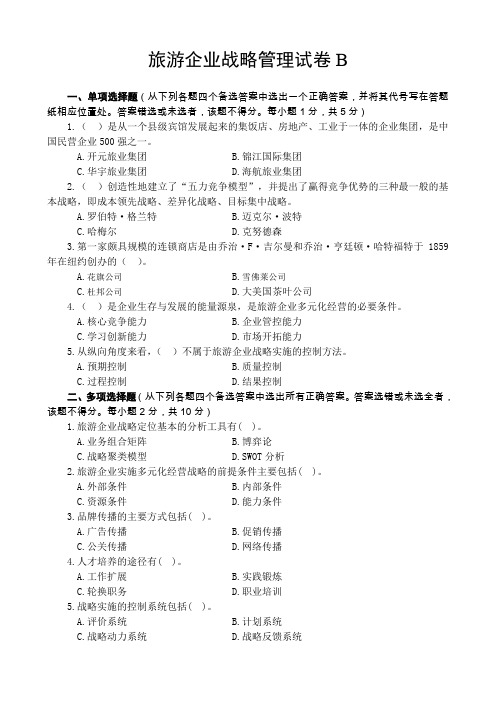
旅游企业战略管理试卷B一、单项选择题(从下列各题四个备选答案中选出一个正确答案,并将其代号写在答题纸相应位置处。
答案错选或未选者,该题不得分。
每小题1分,共5分)1.()是从一个县级宾馆发展起来的集饭店、房地产、工业于一体的企业集团,是中国民营企业500强之一。
A.开元旅业集团B.锦江国际集团C.华宇旅业集团D.海航旅业集团2.()创造性地建立了“五力竞争模型”,并提出了赢得竞争优势的三种最一般的基本战略,即成本领先战略、差异化战略、目标集中战略。
A.罗伯特·格兰特B.迈克尔·波特C.哈梅尔D.克努德森3.第一家颇具规模的连锁商店是由乔治·F·吉尔曼和乔治·亨廷顿·哈特福特于1859年在纽约创办的()。
A.花旗公司B.雪佛莱公司C.杜邦公司D.大美国茶叶公司4.()是企业生存与发展的能量源泉,是旅游企业多元化经营的必要条件。
A.核心竞争能力B.企业管控能力C.学习创新能力D.市场开拓能力5.从纵向角度来看,()不属于旅游企业战略实施的控制方法。
A.预期控制B.质量控制C.过程控制D.结果控制二、多项选择题(从下列各题四个备选答案中选出所有正确答案。
答案选错或未选全者,该题不得分。
每小题2分,共10分)1.旅游企业战略定位基本的分析工具有( )。
A.业务组合矩阵B.博弈论C.战略聚类模型D.SWOT分析2.旅游企业实施多元化经营战略的前提条件主要包括( )。
A.外部条件B.内部条件C.资源条件D.能力条件3.品牌传播的主要方式包括( )。
A.广告传播B.促销传播C.公关传播D.网络传播4.人才培养的途径有( )。
A.工作扩展B.实践锻炼C.轮换职务D.职业培训5.战略实施的控制系统包括( )。
A.评价系统B.计划系统C.战略动力系统D.战略反馈系统三、名词解释(每小题3分,共15分)1.企业宏观环境2.企业哲学3.差异化战略4.旅游企业市场细分5.企业资源计划四、简答题(回答要点,并简明扼要作解释。
旅游企业战略管理(双语)案例3

QTIC-Y Climate Change Workshop Griffith Uni, August 2008QTIC-Y Climate Change WorkshopGriffith Uni, August 2008Not for profit organisationProvides a focal point for the tourism industryAdvocates industry needs to governments Represents 23 sectors associations and 14 Regional Tourism Organisations→Helps to create a stronger tourism industryQTIC-Y Climate Change WorkshopGriffith Uni, August 2008Tourism is one of the front lines in the climate change QTIC-Y Climate Change WorkshopGriffith Uni, August 2008Awareness is rising: •with industry •with consumersQTIC-Y Climate Change WorkshopGriffith Uni, August 20082030:A suburban couple in their late 30s [in Illinois, US], are trying to decide where to go for a winter vacation beforehe asks. “It’ll be warm at that time QTIC-Y Climate Change WorkshopGriffith Uni, August 2008Australia/Queensland –and tourism within it –is potentially in a high impact zone.QTIC-Y Climate Change WorkshopGriffith Uni, August 2008The Great Barrier Reef is Australia’s single most important natural QTIC-Y Climate Change WorkshopGriffith Uni, August 2008threatened but has also beenQTIC-Y Climate Change Workshop Griffith Uni, August 2008QTIC-Y Climate Change WorkshopGriffith Uni, August 2008Local/regional research and informationQTIC-Y Climate Change WorkshopGriffith Uni, August 2008Operational practices (energy, water, etc.)QTIC-Y Climate Change WorkshopGriffith Uni, August 2008and needs to beQTIC-Y Climate Change WorkshopGriffith Uni, August 2008If we remain absent in the debate, we will be overtaken by events, by other industry interests and by our competitors.QTIC-Y Climate Change WorkshopGriffith Uni, August 2008National Climate Change Adaptation Framework –Council of Australian Governments (COAG) 13 April 2007QTIC-Y Climate Change WorkshopGriffith Uni, August 2008July 2008;Prof Ross Garnaut release his ‘Garnaut Report’The Federal Government releases itsCarbon Pollution Reduction Scheme Green Paper’QTIC-Y Climate Change WorkshopGriffith Uni, August 2008Tourism is part of the problem…it is up to us to make it a (far bigger)。
中山大学旅游管理课程介绍(双语班)
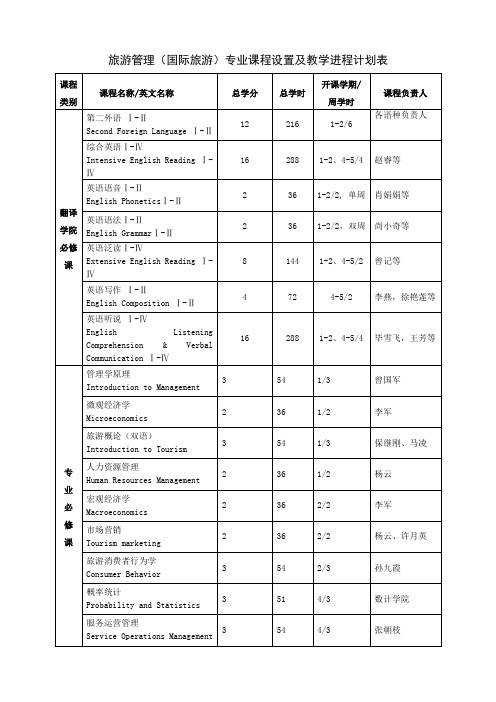
54
7/3
饶勇
酒店成本会计
Hotel Cost Accounting
3
54
8/3
外聘
酒店收益管理
Hotel Revenue Management
3
54
8/3
外聘
酒店督导管理
Supervision in the Hospitality Industry
2
36
8/2
饶勇
休
闲
与
俱
乐
部
管
理
选
修
课
休闲与体育旅游
2
36
10/2
戴耀宗
旅
游
规
划
与
管
理
选
修
课
旅游规划与公共政策
Tourism Planning and Public Policy
3
54
7/3
徐红罡
景区经营管理
Tourist Destination Managemen
旅游电子商务
Tourism E-Commerce
3
54
8/3
吴浩存
社区旅游规划与管理
Community-Based Tourism Planning and Management
3
54
8/3
孙九霞
旅游目的地营销
Tourism Destination Marketing
3
54
8/3
外聘
景观设计
Landscape Design
3
54
8/3
林敏慧
服务实习
Practice
英语写作 Ⅰ-Ⅱ
English Composition Ⅰ-Ⅱ
- 1、下载文档前请自行甄别文档内容的完整性,平台不提供额外的编辑、内容补充、找答案等附加服务。
- 2、"仅部分预览"的文档,不可在线预览部分如存在完整性等问题,可反馈申请退款(可完整预览的文档不适用该条件!)。
- 3、如文档侵犯您的权益,请联系客服反馈,我们会尽快为您处理(人工客服工作时间:9:00-18:30)。
Growth Strategies
• Internal Strategies • Market penetration • Market development • Applications development • Product (service) development • External Strategies • Horizontal integration • Alliance formation (will address this in
Strategic Restructuring
3
4
Page 1
The 5Qs of strategic choice
• There are five questions (the 5Qs) that affect strategic choice:
1. Does the organisation plan to grow? 2. What products and services does it plan to produce? 3. What customer and geographic markets does it plan to service? 4. What generic strategy does it plan to follow to position itself uniquely against competitors? 5. What position does it plan to hold in the future?
7
• Three concerns:
• what to invest in? • implications for scope and complexity? • timing?
greater detail in Week 7)
8
Page 2
Internal Growth Strategies
Market penetration
Internal Growth Strategies
Market development
• Objective: Cultivate new market segments for existing services • Invest: Marketing programs, new distribution channels, new sales staff, capacity... • Scope: Increases the number and type of markets served
5
Business-Level Strategies
• Growth strategies
Internal
• • • • Market penetration Market development Applications development Product (service) development Where? What? How? When?
Strategic Direction
Strategy Formulation (corporate and business level)
Strategy Implementation and Control
• Selection of strategies • Management of resources
11
Market Development
Services
Function Served
Markets Served
Processes/Activities
12
Page 3
Internal Growth Strategies
Application development
• Objective: Apply the service product to new applications. • Invest: Applications development, testing, marketing programs, new distribution channels, new sales staff, capacity... • Scope: Increases the number and type of functions served, and possibly the number and type of markets served
Week 5: Business-level Strategic Options
1
2
Business-Level Strategy Formulation Responsibilities
Internal and External Analysis
• Direction setting • Situation analysis
Market Penetration
Services These are the dimensions of business definition (organisational scope).
Function Served
Markets Served
Processes/Activities
9
10
Differentiation Cost leadership Best cost Focus
15
Product Development
Services
Function Served
Markets Served
Processes/Activities
16
Page 4
Growth Strategies
• Internal Strategies
• Market penetration • Market development • Applications development • Product and/or service development
Learning Objectives 3001HSL
To understand:
internal growth strategies external growth strategies the timing of growth moves generic competitive strategies competitive strategy implementation in international markets the implications of stages in the product life cycle
External (Week 7)
• Competitive strategies
Cost leadership Differentiation Best cost Focus
6
Growth Strategies ….
• Involve investment in resources
All key stakeholders agree Mature market with high exit barriers Private organisations that want to preserve control Relevant to sport, leisure, event, tourism, hospitality sectors? Is bigger always better? Restructuring (temporary condition)
• External Strategies
• Horizontal integration • Alliance formation
17
18
External Growth Strategies
Strategic alliances & joint ventures
• Objective: To gain access to the capacity and/or capability of another organisation. • Invest: In cooperative initiatives, management team, project resources. • Scope: Provides a mechanism for extending scope.
We’ll address strategic alliances and joint ventures in much greater detail in Week 7
19
Stability Strategies
• Not typical in publicly-held organisations • May be appropriate if:
13
Application Development
Services
Function Served
Markets Served
Processes/Activities
Байду номын сангаас
14
Internal Growth Strategies
Product development
• Objective: Develop new service products and modifications that will lead to sales in new and existing market segments, possibly for new applications. • Invest: Service product development, process development, applications development, testing, marketing programs, new distribution channels, new sales staff, capacity... • Scope: Increases the number/type of services, processes, functions served, and possibly the number and type of markets served
